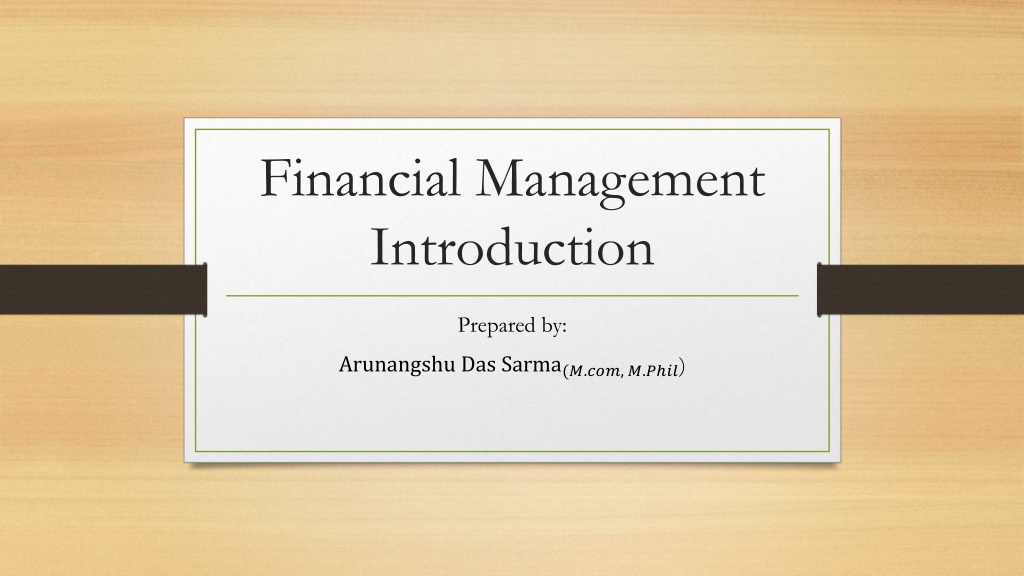Understanding Financial Management: Key Concepts and Objectives
Finance involves managing economic resources effectively, with financial management focusing on procuring and utilizing funds to achieve organizational goals. This discipline entails key functions such as fund procurement and utilization. The objectives of financial management include profit maximization, EPS and return on equity maximization, and wealth maximization which focuses on maximizing the net present value of future cash flows.
Download Presentation

Please find below an Image/Link to download the presentation.
The content on the website is provided AS IS for your information and personal use only. It may not be sold, licensed, or shared on other websites without obtaining consent from the author. Download presentation by click this link. If you encounter any issues during the download, it is possible that the publisher has removed the file from their server.
E N D
Presentation Transcript
Financial Management Introduction Prepared by: Arunangshu Das Sarma(?.???, ?.? ??)
What do we mean by the term Finance? Finance refers to all the economic resources including money and its equivalent. To finance means to arrange for funds and to utilize them effectively for the enterprise, keeping in mind the objective of the organization.
So what is Financial Management? Financial management is the art and science of managing the economic resources. It is the managerial activity undertaken to procure and utilize funds in order to achieve the broader objective of the organization.
Basic Functions of Financial Management The two primary functions in which financial management deals are:- Procurement of Funds Funds can be collected from various sources, attaining the proper mix of which is a very complex problem considering the varying risk, cost associated with them and degree of control of the lenders on the firm. Effective utilization of Funds Funds so collected should be utilized in projects that would earn at least the minimum rate of return required to satisfy the lenders of the funds.
Objectives of Financial Management The major functions of financial management are as follows:- Profit Maximisation EPS and Return on Equity Maximisation Wealth Maximisation
Profit Maximization The maximization of profit is seen as an implied objective of any business, therefore net profit of a firm is often considered as a yardstick to measure efficiency. However this objective suffers certain limitations:- The concept of profit is vague and ambiguous the concept of profit ignores time value of money The concept of profit ignores risk
Wealth Maximization Wealth maximization criteria is based on concept of cash flow generated, rather than the accounting profit. Shareholders wealth maximization mean maximizing the net present value of the future cash flows. The wealth maximization objective is generally in accord with the interest of the various stakeholders such as owners, employees, creditors and the society, Owing to the limitations in profit maximization, in today s world situation which is uncertain and multi-period in nature, wealth maximization is a better objective.
Role of a Chief Financial Officer (CFO) The role of a CFO has become ever so challenging with time. His action has its influence on the size, profitability, growth, risk and survival of the firm. However some of the functions of a CFO can be summarised as under:- Financial analysis and planning Taking investment decisions Taking financing, capital structure, and working capital decisions Risk management
Financial Environment in which a Firm has to Operate Managing finance is one of the most basic and major role of a financial manager. Finance managers may be deployed in many different environment, including public and private sector organizations like financial institutions, general businesses, manufacturing enterprises. The role of the finance manager might vary with the size of the company. For larger companies, he might me be entrusted with complex strategic analysis, while a smaller organization may require him to finalise the accounts.
What is time value of money? The preference for money now, as compared to future money is called Time Preference of Money or Time Value of Money A rupee today is more valuable than a year hence. As today we might be in a position to purchase more goods with the money that what we are going to get with the same amount one year hence. Therefore we prefer to have money today, rather than to have it later.
Reasons for Time Preference of Money Investment opportunities Future uncertainty Preference for present consumption Inflation
Techniques of Time value of Money Compounding Techniques or Future Value Techniques Discounting Techniques or Present Value Techniques
Compounding or Future Value Techniques Future Value of a single sum of money:- ? = ?(1 + ?)? = ? ???(?,?) F = Future Value after n periods P = Present Value i = Interest per rupee per compounding period n = number of compounding period
Compounding or Future Value Techniques For Annuity paid at the end of each period (Annuity is a constant sum paid after a regular interval) 1+?? 1 FV= ? [ ] ? = A*?????,?
Illustration 1 A person decides to invest 6,000 at the end of each year for 8 years. If his expected rate of return (compounded annually) is 12% p.a. What will be the total accumulation at the end of 8thyear? Solution: Annuity = 6,000. Interest per rupee (i)= 12/100= 0.12. Number of year (n)= 8 FV = 6000(1+0.12)^8 1 = 6,000*12.3= 73,800 0.12
Compounding or Future Value Techniques For Annuity paid at the beginning of each period 1 + ?? 1 ? ?? = ? (1 + ?) =A*?????.? (1 + ?)
Illustration 2 In the same illustration 1, if the person invests the money at the beginning of each year and wants to know the accumulated value at the end of 8th year. 1+0.128 1 0.12 Solution: FV= 6,000 1 + 0.12 = 6,000*12.3*1.12= 82656.
Discounting or Present Value Techniques To find the future value we use F = ?(1 + ?)? , therefore to find the present value (P), we need to solve the equation for P So discounted value of a single cash flow can be found as ? 1 P= 1+?? = F* 1+?? = F*????,?
Discounting or Present Value Techniques Present Value technique, if the flow occurs at the end of the period ? = ?[1 1 + ? ? ] ? = A*?????,?
Illustration 3 In an instalment purchase scheme, Mr X is required to pay 2,000 p.m. for 24 months at the end of each month. If the interest rate is 12% p.a., calculate the cash price of the asset. 12 Solution: A= 2,000; i= 100 12 ???? ?= 0.01; n=24 PV= 2,000[1 (1+0.01)^ 24 ] = 2,000*21.2276 = 42,455.20 0.01
Discounting or Present Value Techniques Present Value technique, if the flow occurs at the beginning of the period. 1 1 + ? ? ?? = ? (1 + ?) ? = A*?????,? (1 + ?)
Concept of Perpetuity Perpetuity is an annuity that occurs indefinitely. In financial decision-making there is not must use of this. The present value of perpetuity can be found out as:- P=? ? Where P = Present value A = Annuity amount i = Interest rate
Concept of Risk and Return Risk is the likelihood that the actual return from the investment may vary from the expected return. There are two risk which are discussed below:- Systematic Risk or Market Risk : It arises due to changes in the economy or industry as a whole and influences the individual firms. This type of risk cannot be diversified. Unsystematic Risk or Unique Risk: This arises from the unique uncertainties of the individual firms. This risk can be diversified. Such risk is of two types- Operating or Business risk and Financial risk
Concept of Risk and Return It has generally been found that risk has a direct relation with return. Thus an investment with low risk, gives low return while an investment with high risk give high return. Therefore, the finance manager is often required to strike a proper balance between the risk and return in order to maximise the wealth of the shareholders. Such a combination is called Risk-Return Trade Off
THANK YOU Arunangshu Das Sarma aru.dassarma@gmail.com























